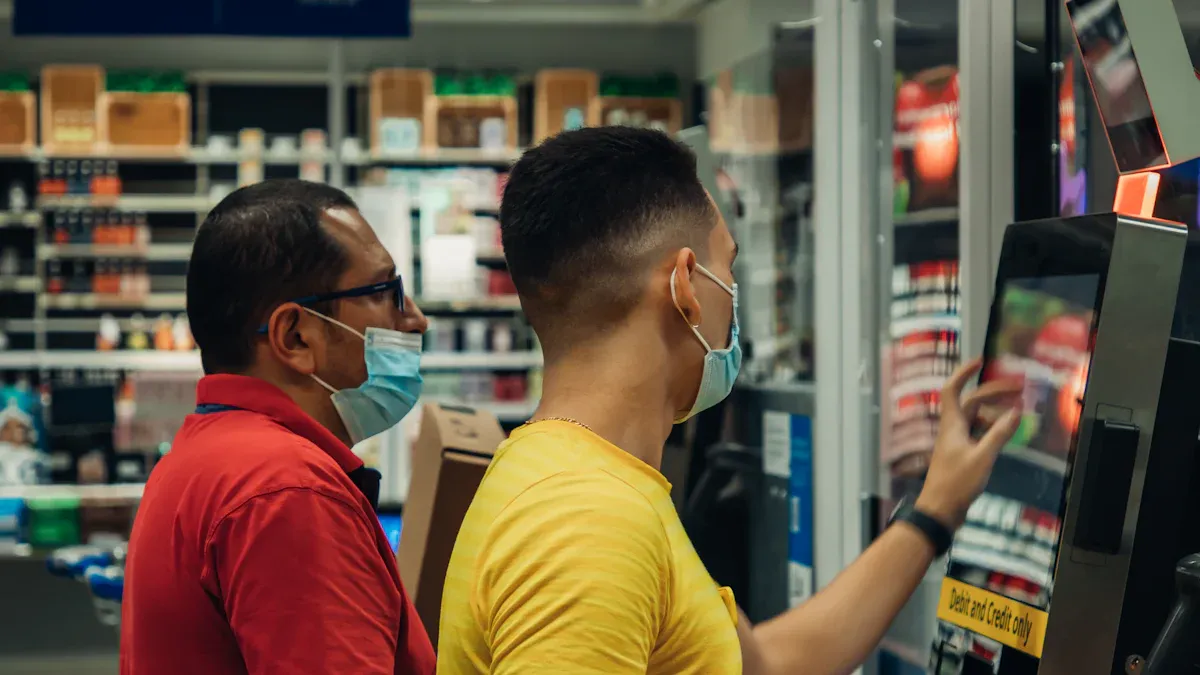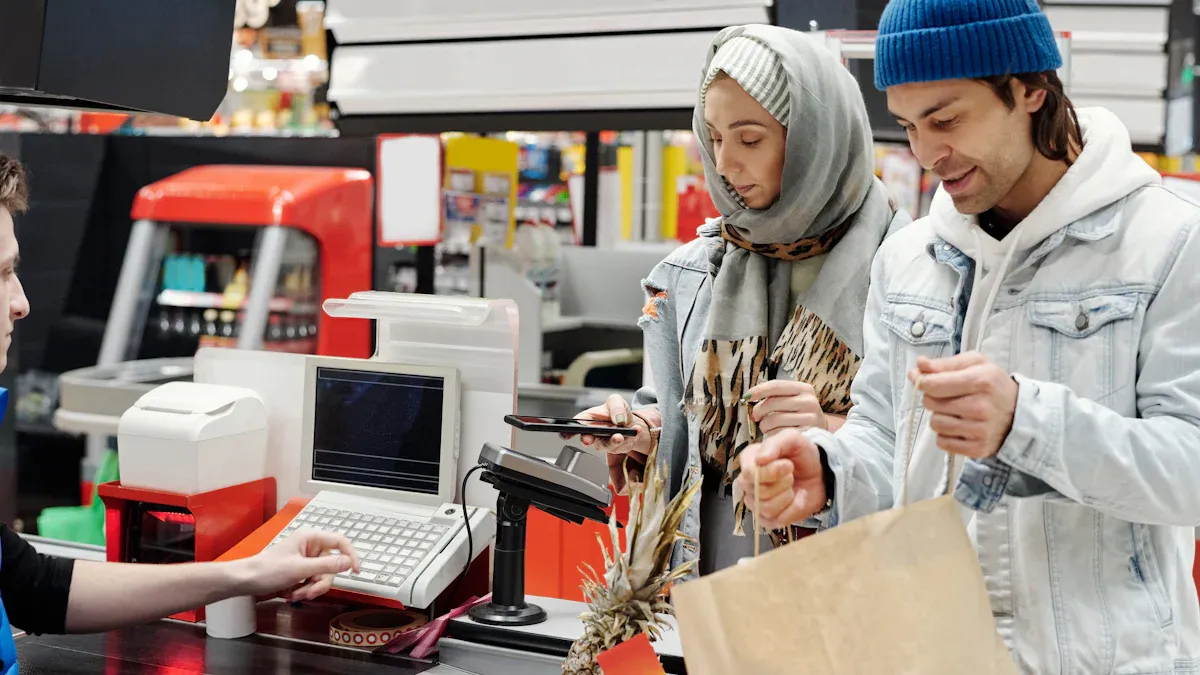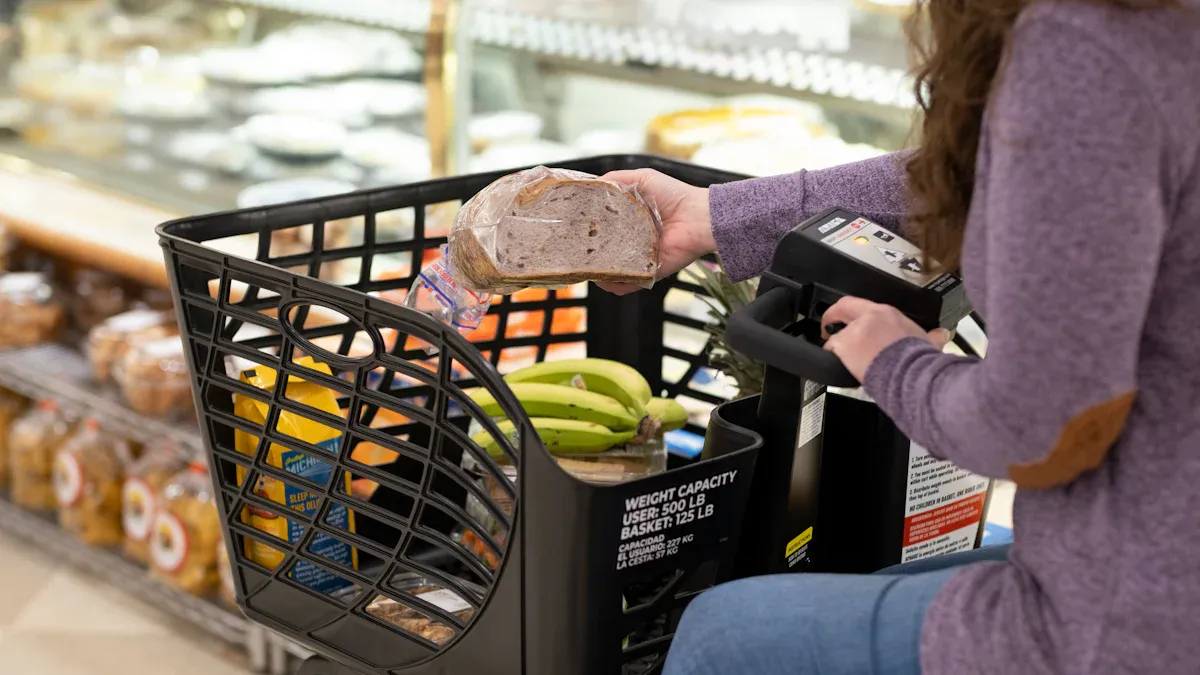Walmart Self-Checkout Security

Walmart self-checkout security plays a crucial role in protecting both shoppers and the store. Many customers appreciate the speed and ease of walmart self-checkout, but they also notice challenges that can affect their experience. Shoppers report concerns such as:
Increased theft and fraud at self-checkout stations compared to regular lanes
Scanning or sensor errors that let unpaid items leave the store
Trouble with age verification for restricted purchases
Frustration with malfunctions and the need for staff help
To address these issues, walmart uses advanced technology and trained employees. This approach aims to keep walmart self-checkout convenient while making sure security stays strong for everyone using self-checkout systems.
Key Takeaways
Walmart uses advanced technology like AI cameras, RFID tags, and invisible barcodes to prevent theft and speed up self-checkout.
Trained staff monitor self-checkout areas closely and help customers while keeping the process safe and smooth.
Security measures include limits on items, payment restrictions, and random receipt checks to reduce shoplifting.
Walmart balances convenience and security by improving technology and adjusting store policies based on customer feedback.
Ongoing improvements and pilot programs help Walmart test new ways to protect shoppers and keep self-checkout efficient.
Walmart Self-Checkout Security Overview
Security Goals
Walmart self-checkout security focuses on protecting both customers and the store. The main goals include increasing security, reducing retail theft, and keeping the checkout process fast. Walmart uses invisible barcodes on product packaging, which help self-checkout systems scan items more accurately. This technology, developed with Digimarc, makes it harder for people to skip scanning items. Walmart also wants to create a controlled and efficient environment at self-checkout stations.
Walmart aims to balance speed and safety. The company adds more supervision for high-value items and checks receipts more often. These steps help prevent thefts while keeping the process smooth for shoppers.
Walmart self-checkout also limits payment methods for large purchases and enforces express lane item counts. The company sometimes changes basket and cart sizes to reduce congestion and make guidelines clear. These security measures support the goal of making walmart self-checkout safe and convenient.
Prevent Thefts Approach
Walmart uses several anti-theft measures to stop self-checkout theft. Employees receive training to spot suspicious actions, such as hiding items or acting nervous. Advanced technology, like AI-powered cameras and weight scales, helps detect when items are not scanned or when the bagging area does not match the purchase.
Walmart sometimes restricts self-checkout to paid members or removes self-checkout lanes in stores with high shoplifting rates.
Random audits at exits let employees check receipts and match them to items in the cart.
Mirrors and special weighing areas help cover blind spots and prevent thefts.
Loss Prevention Officers watch shoppers and monitor self-checkout systems for unusual activity.
Walmart analyzes transaction data to find patterns of shoplifting. Real-time alerts notify staff if something seems wrong. The company also changes store layouts to reduce frustration and make it easier to watch for theft. These steps show how walmart self-checkout security works to prevent thefts and protect both customers and the business.
Technologies Used
AI and Cameras
Walmart self-checkout systems use advanced technology to keep stores safe. AI-powered surveillance plays a big role in this process. Cameras watch every self-checkout lane and use computer vision to track items as customers scan them. The system, called Missed Scan Detection, can spot when someone forgets to scan an item or tries to skip it. When this happens, the system sends an alert to a staff member right away. This technology helps reduce theft and scanning mistakes.
AI and RFID work together to make surveillance more accurate.
Cameras can see items moving into bags without being scanned.
The system has been used in over 1,000 stores and has helped lower theft and fraud.
AI-powered surveillance does not get tired or distracted. It can catch mistakes that people might miss. This makes the checkout process safer for everyone.
RFID and Invisible Codes
Walmart uses both RFID and invisible barcodes to stop theft and speed up checkout. RFID tags store product information. When a customer scans an item, sensors check the RFID tag to make sure the scan is real. If someone tries to skip a scan, the system knows right away.
Invisible barcodes, made with help from Digimarc, cover the whole product package. Customers do not need to find a barcode. They can scan any part of the item, which makes checkout faster and reduces the chance of missing a scan. This technology also makes it harder for people to steal because the system can detect almost every item.
AI and RFID work together to monitor transactions and spot problems.
Invisible barcodes are now on many private-label products.
Walmart spends millions each year to improve these systems.
These tools help Walmart self-checkout lanes stay secure and efficient. They also help staff focus on helping customers instead of only watching for theft.
PIN Pad Security
PIN pad security is another important part of Walmart self-checkout. The yellow-rimmed PIN pads stand out and remind customers to protect their payment information. These pads use encryption to keep card data safe during transactions. The system checks for tampering and alerts staff if something seems wrong.
AI and RFID help make sure only real transactions go through.
PIN pads add another layer of security to the checkout process.
Walmart combines these technologies to create a strong defense against theft. AI-powered surveillance, RFID, and invisible barcodes all work together to monitor transactions in real time. This teamwork helps keep stores safe and gives customers a better shopping experience.
How Walmart Self-Checkout Works

Scanning Process
Walmart self-checkout offers a simple and fast way for customers to pay for their items. Many shoppers use the Walmart app and the “Scan & Go” feature to make the process even easier. Here is how the scanning process works:
Open the Walmart app and select “Scan & Go” from the Store Mode page. Make sure location access is on.
Use a mobile device to scan each item as it goes into the cart.
Tap “View cart” in the app to check all scanned items and prices.
When shopping is done, tap the blue “Check out” button and confirm the payment method.
Go to the self-checkout station and scan the QR code at the register using the app.
Complete the payment in the app.
Show the receipt barcode in the app to an employee when leaving the store.
Walmart has also added invisible barcode technology to many store-brand products. Shoppers can move items over the scanner without searching for a visible barcode. This speeds up the process and makes walmart self-checkout more convenient.
Staff and Loss Prevention
Walmart staff play a key role in keeping self-checkout areas safe. Employees monitor registers remotely using mobile phones. AI-powered missed-scan detection technology sends alerts if the system finds a problem. Staff can pause machines to stop further scanning when needed.
Employees receive training to approach customers in a friendly way. They often blame machine errors instead of accusing shoppers.
Staff notify managers or security if they suspect theft. Regular employees do not confront customers directly.
Asset-protection teams handle cases of suspected theft.
Cameras and sensors help staff spot unscanned items and act quickly.
Employees focus on customer safety and a positive experience during any intervention.
Walmart uses these steps to support both security and customer service. The system helps staff prevent theft while making walmart self-checkout smooth for everyone.
Effectiveness Against Self-Checkout Theft

Theft Reduction
Walmart has faced ongoing challenges with theft at self-checkout stations. Recent surveys show that about 15% of self-checkout users admit to stealing on purpose. Nearly half of those say they would do it again. Walmart’s estimated losses from retail theft grew from $3 billion in 2021 to $6.5 billion in 2023. These numbers highlight the need for strong security measures.
Some stores have responded by removing self-checkout machines. For example, the Shrewsbury Walmart saw a big drop in theft-related incidents after making this change.
Metric | Jan-May Previous Year | Jan-May Current Year | Change Description |
|---|---|---|---|
Police Calls | 509 | 183 | Significant drop after removing self-checkout |
Arrests | N/A | >50% decrease | Arrests fell by more than half after removal |
Walmart also uses new technology to combat theft. AI-powered cameras and RFID tags help spot unscanned items. Early results show faster transactions and better theft detection. These steps help reduce shoplifting and improve safety for everyone.
Policy Enforcement
Walmart enforces strict policies to deter theft. Stores set limits on the number of items allowed at self-checkout. Some locations only let Walmart+ members or delivery drivers use these lanes. Staff monitor transactions and use advanced video surveillance to watch for suspicious activity.
Clear signs remind customers about video security and the store’s rules.
If someone gets caught trying to steal, the consequences can be serious. Depending on the value of the items, a person may face fines, court appearances, or even jail time. Walmart uses security footage and employee reports to support claims of theft. First-time offenders might get a chance for community service or a plea deal, but a conviction can affect jobs and housing.
Walmart continues to test new ways to reduce shoplifting and protect both shoppers and the business.
Customer Impact
Convenience vs. Security
Walmart customers have mixed feelings about self-checkout. Some shoppers enjoy the speed and efficiency. They can finish shopping faster, and data shows self-checkouts can cut checkout times by up to 50%. Others find the process confusing or stressful. Many people dislike technical problems, false alarms, and long lines. Some feel like they are doing the work of a cashier without any reward. Overcharging errors and accidental non-scans also cause frustration.
Many customers prefer traditional cashier lanes for a more personal touch and fewer mistakes.
Walmart has noticed these concerns. The company has started to reduce self-checkout lanes in some stores or limit their use. This helps balance convenience with security and improves the self-checkout experience for everyone. Walmart also uses new technology, like AI and computer vision, to make the process faster and more accurate. These changes aim to help both shoppers and the store.
Privacy and Data
Walmart uses AI-powered cameras at self-checkout stations to watch for theft. This technology helps keep stores safe, but it also raises privacy questions. Many customers do not know that AI is watching their actions. Some worry about how long Walmart keeps the video and if the system collects personal information.
Some employees say the cameras sometimes mistake normal actions for theft.
Customers and workers have concerns about fairness and privacy.
People want to know how long Walmart stores the data and if it includes identifying details.
Walmart says the technology helps reduce theft and keeps shoppers safe, but privacy questions remain.
Customers want a safe and easy checkout, but they also care about their privacy. Walmart continues to look for ways to protect both.
Future of Walmart Self-Checkout
New Security Measures
Walmart continues to test and introduce new security measures to protect its stores and customers. The company has started pilot programs where employees wear body cameras, similar to those used by police officers. These cameras help record interactions and may reduce theft or violent incidents. Walmart also plans to increase active supervision at self-checkout stations, especially for high-value items. More frequent receipt checks at store exits will help catch missed scans or unpaid items.
Walmart is exploring advanced tools inspired by law enforcement, such as license plate readers and anti-theft shopping carts. These carts can lock their wheels if someone tries to leave without paying. The company will enforce stricter item limits in express lanes and introduce new basket and cart sizes to reduce congestion. More employees will assist customers at self-checkout, making the process safer and smoother.
Walmart tests these changes in select markets before deciding if they should be used in all stores. This careful approach helps the company find the best ways to enhance security and improve the shopping experience.
Ongoing Improvements
Walmart works with technology partners to keep improving self-checkout security. The company uses bright yellow rims around PIN pads to stop criminals from attaching card skimming devices. Walmart also partners with Digimarc to add invisible barcodes to product packaging. These barcodes let customers scan items from any angle, which speeds up checkout and reduces theft.
The company uses AI-powered monitoring systems that watch transactions in real time. These systems can spot suspicious behavior and alert staff quickly. Walmart limits self-checkout access in some stores to Walmart+ members and delivery drivers. Predictive analytics help the company prepare for risks by studying past data.
Improvement | Description | Security Impact |
|---|---|---|
AI-powered monitoring systems | Real-time transaction analysis to detect suspicious behavior and prevent theft and fraud. | Identifies unusual activities and employee fraud discreetly. |
Invisible barcodes | Barcodes embedded in product packaging scanned from any angle to speed up checkout. | Reduces scanning errors and theft opportunities. |
Limited self-checkout access | Restricting self-checkout to Walmart+ subscribers and Spark delivery drivers. | Reduces misuse and supports security. |
Predictive analytics and data integration | Uses historical data to forecast risks and prepare for disruptions. | Anticipates threats and improves system readiness. |
Retailers like Walmart now use new anti-theft technology, such as smart cameras and computer vision, to watch for suspicious actions. These tools help balance security with customer convenience and keep stores ready for future challenges.
Walmart self-checkout security uses a mix of technology and staff to protect stores and shoppers. Walmart invests in AI-powered cameras, RFID tags, and invisible barcodes to stop theft and make checkout faster. The company learns from real-world challenges and adjusts its approach to keep both security and convenience in balance. Many retailers now follow Walmart’s lead, using flexible strategies that combine technology with human service. As self-checkout evolves, Walmart continues to build trust and improve the shopping experience.
FAQ
How does Walmart detect theft at self-checkout?
Walmart uses AI-powered cameras and sensors to watch for missed scans. Staff receive alerts if the system finds a problem. This technology helps catch theft quickly and keeps the checkout process safe.
Are customers recorded while using self-checkout?
Yes, Walmart records video at self-checkout stations. Cameras help prevent theft and protect shoppers. The company uses this footage for security purposes only.
What happens if the self-checkout system makes a mistake?
Staff can help fix scanning errors or payment issues. Employees receive training to handle these problems politely. Customers should ask for help if they notice a mistake.
Can shoppers use cash at Walmart self-checkout?
Most Walmart self-checkout stations accept cash, cards, and mobile payments.
Some locations limit payment types for large purchases.
Shoppers can check the payment options on the screen before starting.
See Also
Common Issues Faced During Walmart Self-Checkout Process
Upcoming Changes To Walmart Self-Checkout Access In 2025
How Walmart Plus Membership Affects Self-Checkout Experience
